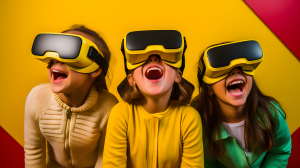VR and AR are exploding right now. VR is virtual reality. AR is augmented reality. Both allow you to play, discover, and learn in totally awesome ways. It’s like entering a video game or experiencing digital things in your actual world. Sounds awesome, right?
Children adore this. Like, genuinely adore it. The technology is shiny, interesting, and so much fun. And let’s be honest—parents love something that will occupy their child for a few moments.
But here’s the deal. These headsets and apps weren’t exactly made for little kids. And some experts are raising eyebrows. Why? Because kids’ eyes and brains are still growing. VR might mess with that. Not always, but enough to be careful.
Some kids get headaches. Others feel dizzy or sick. And a few just zone out. That’s not great, especially when you’re 8 years old.
So yeah, while AR and VR are the future (and also really cool), they may not be optimal for super little users.
Wanna know how old is a good age? What the tech companies say is good? What doctors say works?
Stay put. We’ve got you covered.
Why Age Even Matters
Okay, so let’s talk about why age does matter with AR and VR. First off—children are not little adults. Their brains and eyes are still developing. Like, a ton. And VR introduces them to a whole other world. Literally.
When a child wears a VR headset, their eyes must adjust to an artificial world. That can confuse their brain. It plays with depth, balance, and even motion. Some children become dizzy. Others become wobbly. And sure, some feel like they just rode off a rollercoaster in 10 minutes.
Also, let’s discuss screen time. You already know gazing at screens for too long is a sucky thing to do. Now picture those screens being an inch from your eyeballs. Continuously. That’s what VR does. It can cause headaches, eye strain, blurry eyes, and just feeling. wrong.
And children don’t always complain when they feel strange. They may push through the ick ’cause they’re enjoying themselves. Not good.
So yes, age is a factor. Putting VR on a 6-year-old is different from allowing a teenager to experiment with it. Their bodies respond differently. And their brains are not prepared for the information overload.
Better safe than sorry, right?
What the Tech Companies Say
So what do the big tech companies have to say about children using VR? Well, it turns out, they’re not completely cool with it either.
Meta (the company that owns Oculus) states that VR is for ages 13 and above. Sony’s PlayStation VR? That’s alright for 12+. HTC Vive and others? Also 13+. So yes, they all pretty much agree—no young kids, okay?.
But why an age limit? Is it simply a legal issue? Not a chance. It’s largely a matter of safety.
You see, these firms understand that VR plays with your senses. It’s a total brain and body deal. And for children whose eyes and brains are still learning the ropes, it could prove too much. They could become motion sick, dizzy, or simply get completely overwhelmed.
Also, tech firms don’t want furious parents descending on them if things go awry. So they cover their backs with age regulations. Common sense.
Bottom line? If the people who are making the headsets say “wait till you’re 13,” perhaps we should take them seriously.
What Doctors and Experts Say
Doctors and brain experts are also waving red flags. They’re not trying to kill the fun—they just want to keep kids safe.
Research shows VR might mess with vision. Like, it could cause blurry eyes or slow down how kids learn to focus. Some studies even say it can mess with sleep. Bright screens that close to the face? Not great for bedtime.
And here’s the tricky part—young kids can’t always say when something feels off. They might feel sick, dizzy, or just weird, but not know how to explain it. That’s kinda scary, right?
Experts suggest that kids under 12 should probably skip VR. It’s not about fear—it’s just about being smart. There’s still so much we don’t know about how VR affects growing brains.
So if your kid’s under 12 and begging for a headset, maybe hit pause. There’s plenty of time for VR later.
Let ‘em enjoy being a kid first.
What About AR?
Alright, now let’s talk about AR—Augmented Reality. It’s kinda like VR’s chill cousin.
Instead of taking you to a whole new world like VR, AR adds cool stuff to the world around you. Think Pokémon Go. Or those filters on Snapchat and Instagram. You’re still in your room, but your screen adds magic on top. No headset. No trippy 3D world.
Sounds safer, right? And yeah, it usually is.
AR isn’t as intense as VR. It doesn’t mess with your balance or make you feel like you’re floating in space. But here’s the catch—it’s still screen time. And we all know too much screen time is a no-go for kids.
Eyes can still get tired. Sleep can still get messed up. And if your kid’s face is glued to a screen all day chasing digital dinosaurs, that’s not exactly healthy.
So yeah, AR is better for younger kids compared to VR. But you still gotta set limits. Keep sessions short. Pick age-appropriate apps. And maybe, just maybe, tell them to look up once in a while and go touch some grass.
Balance is everything.
Parent Tips – If Your Kid Really Wants to Try
Alright, so your child is begging incessantly. You’ve already said “no” a record five times. But now you’re having the thought, “Well, a little bit can’t possibly hurt?” Totally understandable.
If you’re going to let them experience VR or AR, do it intelligently. First rule? Keep it brief. Like 5 to 10 minutes at most. Seriously. That’s all they need to get the thrill. Long sessions = tired eyes and wobbly legs.
Next up watch them like a hawk. If they start rubbing their eyes, feeling dizzy, or acting weird, it’s time to stop. No “one more minute” stuff.
Take real breaks. Not “pause the game and scroll your phone” breaks. We’re talking go get a snack, stretch, maybe even run around outside for a bit.
Also, use kid-safe content only. There’s a lot of wild VR stuff out there—not all of it is made for little minds. Look for apps with age ratings or ones made just for kids.
And please—be in the room while they play. Don’t just hand them the headset and dip. Stay nearby. Watch. Ask how they’re feeling.
Tech can be fun and safe—if you’re there to guide it.
So, What’s the Ideal Age?
Alright, let’s answer the big question—when can kids actually start using VR or AR?
For VR, most experts and tech companies agree: 12 or 13 and up is the sweet spot. That’s when the brain and eyes are more developed. Kids can handle the motion better. Plus, they’re better at saying, “Hey, I feel weird,” if something’s off.
As for AR? It’s a bit more chill. No headsets. No full-on fake worlds. So yeah, it’s okay for younger kids—but that doesn’t mean toddlers should be running around chasing digital monsters all day. Still needs limits.
Here’s a simple way to think about it: If you wouldn’t give your kid a smartphone yet, maybe skip the VR too. The tech is cool, but it’s intense. And kids don’t always know their limits.
So don’t rush it. There’s plenty of time for virtual roller coasters and space adventures. Let them grow up a bit first.
And when the time’s right? Let ‘em explore—with you by their side.
Look, no one’s saying VR and AR aren’t awesome. They totally are. Flying through space, playing games in 3D, catching wild creatures in your backyard—it’s next-level cool.
But cool doesn’t always mean safe, especially for young kids. Their brains and eyes are still figuring stuff out. And sometimes, tech can throw that off balance.
So here’s the move: Be chill, but be smart. If your kid’s old enough (like 12 or 13+), start slow. Watch how they react. Keep it short. Use good content. And always stay close.
And if you’re unsure? That’s okay. When in doubt, wait it out. Tech will still be here when they’re ready.
Your kid’s health > hype.




